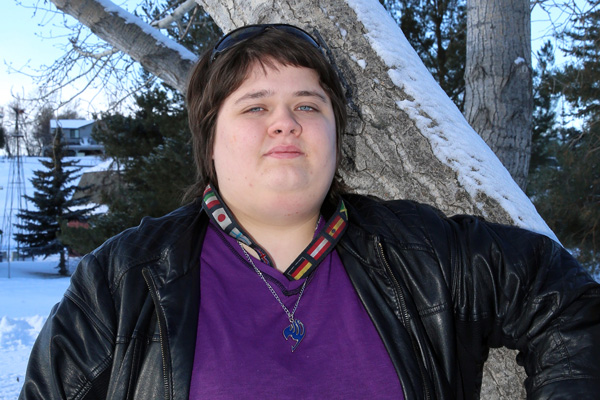Jenna Aitken:
“There was so little local support for kids like us.”
Jenna Aitken was five years old when her family moved from their home in Lloydminster, Alberta, a thousand kilometers north to Hay River, a town on the southern shore of Great Slave Lake in Canada’s Northwest Territory. Jenna’s father Chris was looking for “a change of scenery” and he found it. The winters were bracing, the landscape stark and the community small.
But as the years passed, the family came to realize that Hay River’s size and isolation had a significant downside. Jenna, who struggled at school from the outset, was ultimately diagnosed with autism, a condition that the Centre for Disease Control estimates affects one in 68 children. In the community of Hay River, population three and a half thousand, medical support for Jenna was hard to come by and the local school had virtually no structures in place to accommodate her.
It took a long time for the Aitkens to put a name on what set Jenna apart from her peers. In her first two years at elementary school, Jenna’s teachers simply characterised her as “slow.” She was made to repeat Grade One. When Chris, a school teacher himself, and his wife, an educational assistant, expressed concerns that something more serious might be afoot, school administrators branded them over-protective parents.
In Grade Two, Jenna was referred to an educational psychologist, who diagnosed her with attention deficit hyperactivity disorder (ADHD). While the school was unable to provide Jenna with any additional support, a generous community member came into the classroom to help Jenna and another boy who was having trouble.
In Grade Five, Jenna’s teacher suggested she be tested for autism which, in the Northwest Territories, is not as easy as it may sound. With no public facilities in the territory offering the test, Jenna, like thousands of others, was put on a waitlist for the Glenrose Rehabilitation Hospital in Edmonton. In Grade Seven, Jenna’s parents received confirmation of what they had suspected; Jenna was high-functioning autistic. And while the diagnosis was a relief of sorts, it didn’t trigger an improvement in Jenna’s school experience. To the contrary.
When Jenna started high school, her parents were told that no extra resources were available; there was no replacement for Marnie, the woman who had volunteered in her elementary and middle schools, and only one overextended staff member had training in special education. Rumours reached Jenna’s parents that an administrator had said it wasn’t worth providing Jenna with additional support because “she won’t graduate anyway.”
Disability and bullying
27% of Canadian high school, college and university students with a disability are being bullied because of their disability, and 35% of students with disabilities in Canada report being avoided or excluded at school because of their disability.Data Source: Canadian Human Rights Commission 2017
Data source: Canadian Human Rights Commission 2017
Persons with disabilities
High-school, college and university students bullied
Of all foster children in Canada
“The teachers were stretched to the limit...”
In fact, Jenna did graduate and with honours. But while she shone academically, her social experience of high school was devastating. She went from having a few friends to none. A natural athlete, she dropped all team sports. Her peers turned against her and it seemed some teachers did too.
“In high school, things got very competitive,” says Jenna, today an assertive and articulate 21-year-old. “It was all about who’s the best? Who’s the prettiest? Certain kids were privileged by the teachers, others were bullied.” Every time the class was asked to form groups or teams, Jenna was left to the end. “The teachers never looked at the kid who was quiet or passive or at the bottom.”
Jenna began to fly into uncontrolled rages. “It’s like a rubber band – there’s only so much it can take before it snaps,” she says.
“She cried every day after school,” says her father, who taught at the same high school and observed the goings-on from within. In Grade Twelve, Jenna was put on suicide watch.
With exceptional family support, Jenna did get through high school. She is now attending community college in Alberta, studying to be an educational assistant. One day, she wants to be able to offer kids the kind of support she so desperately needed in high school. But despite the painful memories, Jenna reflects on her experience with equanimity.
“The teachers were stretched to the limit,” she says. “It wasn’t just me. There were a lot of kids that needed help – with fetal alcohol syndrome, Asperger’s, autism. Some didn’t get diagnosed, their parents were just terrified. There was so little local support for kids like us.”
Her father agrees. “The high school probably believes it did the best with the resources it had,” he says, adding that he and his wife, with their education, income, and insights into the school system, were at a huge advantage compared to many. “Most people wouldn’t dare speak up.”
He’s delighted to see Jenna thriving – enjoying her studies, making friends and going out on the weekends. She has started afresh in Alberta. He has great hopes, but the fears linger. “She hates coming back here,” he says.
In 2016, the Commission conducted a study on education and persons with disabilities, as part of efforts to monitor Canada’s implementation of the UN Convention on the Rights of Persons with Disabilities. The study found that students with disabilities encounter barriers to full participation, and are excluded and even bullied because of their disability.
Incomplete education
37% of persons with disabilities in Canada are taking fewer courses because of their disability, and 11% are choosing to end their education early because of their disability.
Data source: Canadian Human Rights Commission 2017
Persons with disabilities
Taking fewer courses because of their disability
Choose to end their education early because of their disability

